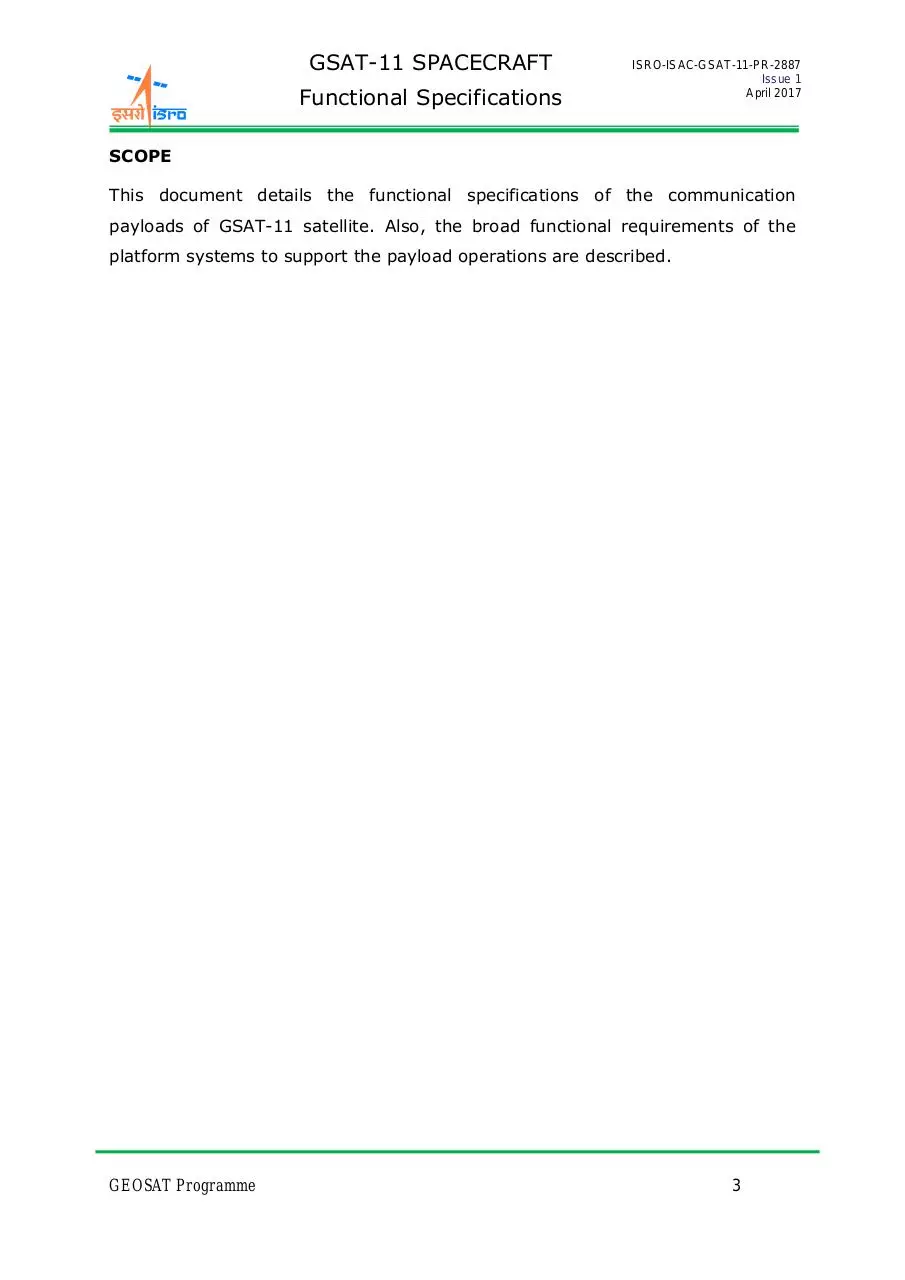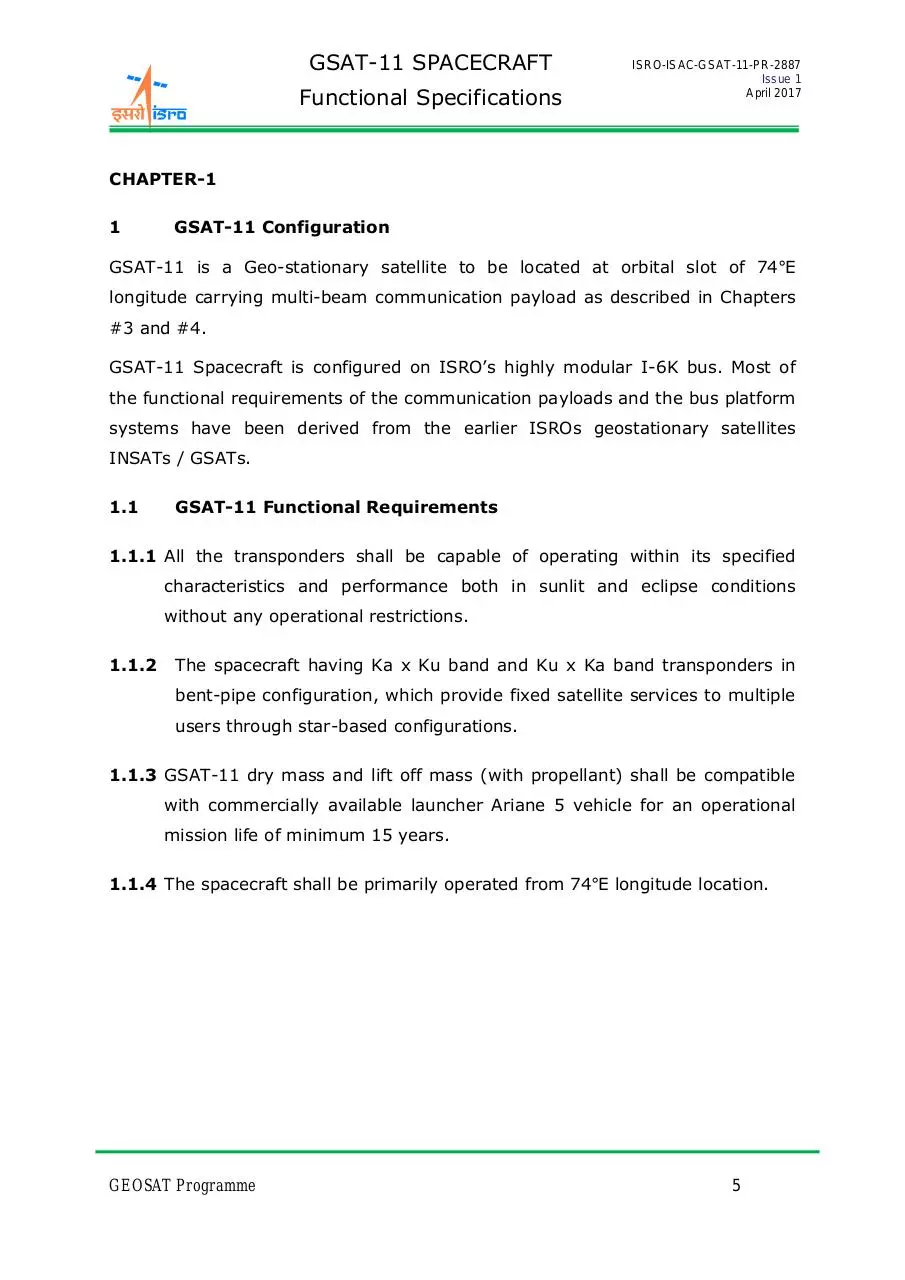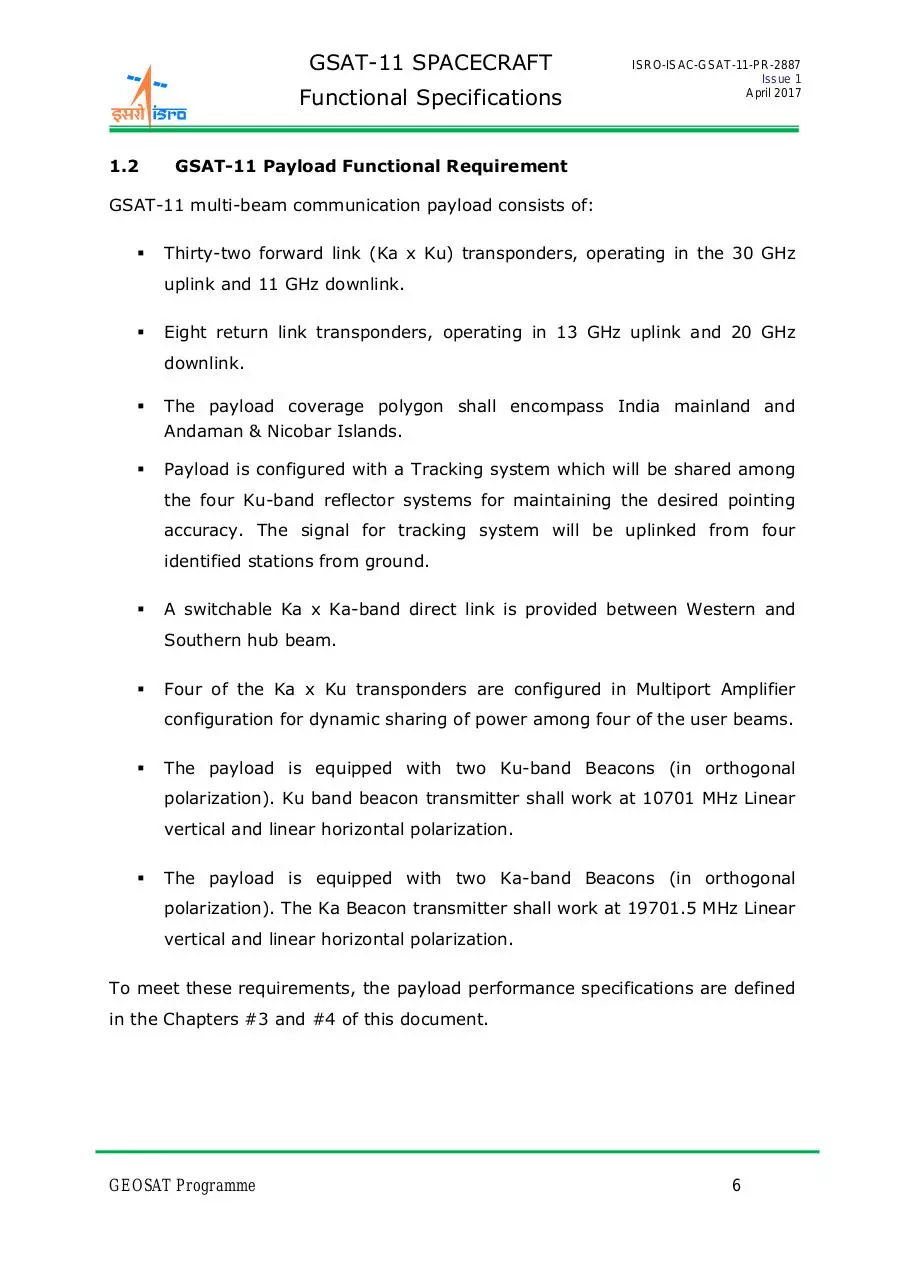IDT00695500000000000isro08502 (PDF)
File information
Author: Bharath K S
This PDF 1.6 document has been generated by PDFsharp 1.2.1269-g (www.pdfsharp.com), and has been sent on pdf-archive.com on 13/09/2017 at 20:33, from IP address 171.78.x.x.
The current document download page has been viewed 747 times.
File size: 2.38 MB (71 pages).
Privacy: public file





File preview
GSAT-11 SPACECRAFT
Functional Specifications
ISRO-ISAC-GSAT-11-PR-2887
Issue 1
April 2017
FUNCTIONALSPECIFICATION
GSAT-11 SPACECRAFT
Functional Specification
April 2017
JANUARY 2013
GEOSAT PROGRAMME
ISRO Satellite Centre
Bangalore
GEOSAT Programme
1
GSAT-11 SPACECRAFT
Functional Specifications
ISRO-ISAC-GSAT-11-PR-2887
Issue 1
April 2017
SCOPE
This document details the functional specifications of the communication
payloads of GSAT-11 satellite. Also, the broad functional requirements of the
platform systems to support the payload operations are described.
GEOSAT Programme
3
GSAT-11 SPACECRAFT
Functional Specifications
ISRO-ISAC-GSAT-11-PR-2887
Issue 1
April 2017
CONTENTS
1
GSAT-11 Configuration.......................................................................... 5
2
GSAT-11 Spacecraft System Requirement ............................................... 8
3
PAYLOAD PERFORMANCE REQUIREMENTS ............................................. 13
4
Beacon Transmitter Performance Requirements...................................... 43
5
Telemetry, Tracking & Command (TT&C) Subsystem .............................. 47
6
Attitude & Orbit Control Subsystem (AOCS) ........................................... 53
7
Propulsion Subsystem ......................................................................... 58
8
Electrical Power Subsystem ................................................................. 61
9
Thermal Control ................................................................................. 64
10 Structure ........................................................................................... 65
11 Spacecraft Support Equipment & Transportability ................................... 66
12 Electromagnetic Interference/Compatibility & Space Charge .................... 67
13 Safety & Handling Hazardous Systems/ Equipments ............................... 68
APPENDIX-A ............................................................................................ 69
Operational Environments ......................................................................... 69
APPENDIX-B ............................................................................................ 70
Environmental Test Requirements .............................................................. 70
GEOSAT Programme
4
GSAT-11 SPACECRAFT
Functional Specifications
ISRO-ISAC-GSAT-11-PR-2887
Issue 1
April 2017
CHAPTER-1
1
GSAT-11 Configuration
GSAT-11 is a Geo-stationary satellite to be located at orbital slot of 74°E
longitude carrying multi-beam communication payload as described in Chapters
#3 and #4.
GSAT-11 Spacecraft is configured on ISRO’s highly modular I-6K bus. Most of
the functional requirements of the communication payloads and the bus platform
systems have been derived from the earlier ISROs geostationary satellites
INSATs / GSATs.
1.1
GSAT-11 Functional Requirements
1.1.1 All the transponders shall be capable of operating within its specified
characteristics and performance both in sunlit and eclipse conditions
without any operational restrictions.
1.1.2
The spacecraft having Ka x Ku band and Ku x Ka band transponders in
bent-pipe configuration, which provide fixed satellite services to multiple
users through star-based configurations.
1.1.3 GSAT-11 dry mass and lift off mass (with propellant) shall be compatible
with commercially available launcher Ariane 5 vehicle for an operational
mission life of minimum 15 years.
1.1.4 The spacecraft shall be primarily operated from 74°E longitude location.
GEOSAT Programme
5
GSAT-11 SPACECRAFT
Functional Specifications
1.2
ISRO-ISAC-GSAT-11-PR-2887
Issue 1
April 2017
GSAT-11 Payload Functional Requirement
GSAT-11 multi-beam communication payload consists of:
Thirty-two forward link (Ka x Ku) transponders, operating in the 30 GHz
uplink and 11 GHz downlink.
Eight return link transponders, operating in 13 GHz uplink and 20 GHz
downlink.
The payload coverage polygon shall encompass India mainland and
Andaman & Nicobar Islands.
Payload is configured with a Tracking system which will be shared among
the four Ku-band reflector systems for maintaining the desired pointing
accuracy. The signal for tracking system will be uplinked from four
identified stations from ground.
A switchable Ka x Ka-band direct link is provided between Western and
Southern hub beam.
Four of the Ka x Ku transponders are configured in Multiport Amplifier
configuration for dynamic sharing of power among four of the user beams.
The payload is equipped with two Ku-band Beacons (in orthogonal
polarization). Ku band beacon transmitter shall work at 10701 MHz Linear
vertical and linear horizontal polarization.
The payload is equipped with two Ka-band Beacons (in orthogonal
polarization). The Ka Beacon transmitter shall work at 19701.5 MHz Linear
vertical and linear horizontal polarization.
To meet these requirements, the payload performance specifications are defined
in the Chapters #3 and #4 of this document.
GEOSAT Programme
6
GSAT-11 SPACECRAFT
Functional Specifications
ISRO-ISAC-GSAT-11-PR-2887
Issue 1
April 2017
From the payload usage point of view, the satellite shall be operated primarily
from 740E geostationary longitudinal location and shall provide communication
services for a minimum of 15 years.
GEOSAT Programme
7
GSAT-11 SPACECRAFT
Functional Specifications
ISRO-ISAC-GSAT-11-PR-2887
Issue 1
April 2017
CHAPTER-2
2
GSAT-11 Spacecraft System Requirement
2.1
Launcher Capability
GSAT-11 spacecraft shall be compatible with commercially available launch
vehicles and from the point of view of:
a. Lift off Mass
b. Interfaces
c. Envelope & load capacity
d. Launch environment
e. Safety requirements
Launch system / Spacecraft INTERFACE CONTROL document and further
revisions as and when done with the launcher agency shall be applicable.
2.2
Functional Redundancy
The satellite shall incorporate parts, components, subassembly, assembly, and /
or
subsystem
functional
redundancy
wherever
necessary.
The
satellite
subsystems shall include fail-safe features wherever feasible i.e., a failure within
a subsystem shall not disable or degrade the remainder of the satellite. Failure
rates for parts shall be assessed as per MIL-STD-217F wherever applicable and
or other relevant data from ISRO documents shall be applicable.
The following shall not be included in computing reliability of the spacecraft:
a. Successful injection into parking orbit by the launch vehicle.
b. Apogee engine performance.
c. Structure and Mechanism elements.
2.3
Design Life
The minimum in orbit mission lifetime of the GSAT-11 spacecraft shall be
15 years (with a design goal of 18 years). Unless otherwise stated, the satellite
GEOSAT Programme
8
GSAT-11 SPACECRAFT
Functional Specifications
ISRO-ISAC-GSAT-11-PR-2887
Issue 1
April 2017
shall be designed to meet all specifications at the End Of Life (EOL). Spacecraft
parts, materials and processes subject to wear / tear out or deterioration due to
environment including radiation, application stresses or inherent physical
processes,
shall
be
designed,
fabricated,
selected
and
used
to
attain
performance life requirements.
2.4
Operating Environments
The spacecraft shall be capable of satisfactory operation in standard laboratory
environments, vacuum (pressure less than or equal to 10-6 torr) and operational
environments during the entire mission. In addition, all conductors shall be
insulated such that they shall not be subject to electrical break down due to any
of the test or operational environments. All subsystems, which are operating
during launch, shall be able to operate in the electromagnetic environments of
the chosen launcher.
The spacecraft design shall take into consideration space charging phenomena.
The spacecraft design shall provide for the electrical connection of all electrically
conductive structural elements of the spacecraft to form a common spacecraft
ground. Provisions shall be made to electrically ground all conductive external
surfaces of the spacecraft. All interface circuits shall be designed to minimize
electrical interference on signal lines/return lines, power bus lines/ return lines
and spacecraft structure.
2.5
Storage
The spacecraft shall be capable of satisfactory operation following storage up to
5 years in its shipping and storage container. Spacecraft batteries shall be
excluded from this storage life time requirements.
2.6
Spacecraft Design / Operation from AIT Point of View
The spacecraft shall be designed:
GEOSAT Programme
9
GSAT-11 SPACECRAFT
Functional Specifications
2.6.1
ISRO-ISAC-GSAT-11-PR-2887
Issue 1
April 2017
To provide ease of access to subassemblies for electrical connections,
mechanical operations, inspection and alignments, taking into account
provisions for any changes or replacements that may be needed on any
test sequence. The power distribution harness is made with the use of
power bus bars, entire generation and distribution chain is double
insulated till fuse end.
2.6.2
To allow tele-metered data to be used during ground testing to the
maximum extent in order to minimize use of test connectors.
2.6.3
To preclude incorrect electrical connections.
2.6.4
To reduce the hazards of incorrect assembly.
2.6.5
To allow selection of all stand-by / redundant units with minimum service
interruption.
Materials used in the spacecraft design and fabrication should be chosen
carefully to protect against the contamination of the spacecraft equipment,
especially solar cells, thermal control surfaces and optical surfaces.
Specific
attention to the magnetic cleanliness shall be given since electromagnetic
devices are used for the control purposes of the spacecraft. Spacecraft testing
shall be accomplished with minimum disturbance to flight connectors. The
spacecraft design shall allow for proper stimulation to various attitude sensors
and the communication subsystem for functional tests at the launch site.
2.7
Launch Window
Launch window for the selected launcher shall be determined by Mission Analysis
and shall be at least 45 minutes each day of the year for the GTO injection orbit.
2.8
Station Keeping
The satellite shall be capable of being maintained during its entire mission life at
a nominal position of 74°E longitude to control orbit inclination to within ±0.1deg
of the equatorial plane and longitude within ±0.1deg of the selected nominal
location along with co-located satellites. The spacecraft shall be designed to
GEOSAT Programme
10
Download IDT00695500000000000isro08502
IDT00695500000000000isro08502.pdf (PDF, 2.38 MB)
Download PDF
Share this file on social networks
Link to this page
Permanent link
Use the permanent link to the download page to share your document on Facebook, Twitter, LinkedIn, or directly with a contact by e-Mail, Messenger, Whatsapp, Line..
Short link
Use the short link to share your document on Twitter or by text message (SMS)
HTML Code
Copy the following HTML code to share your document on a Website or Blog
QR Code to this page

This file has been shared publicly by a user of PDF Archive.
Document ID: 0000673101.